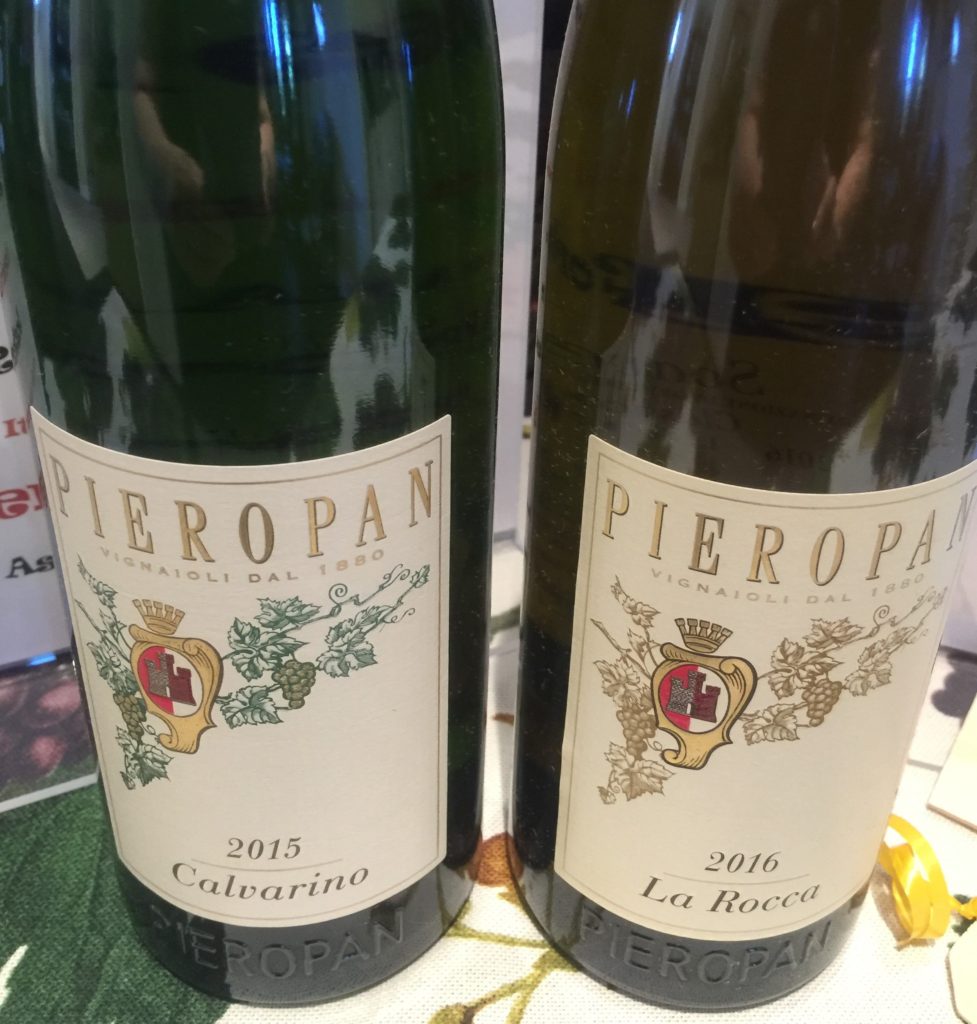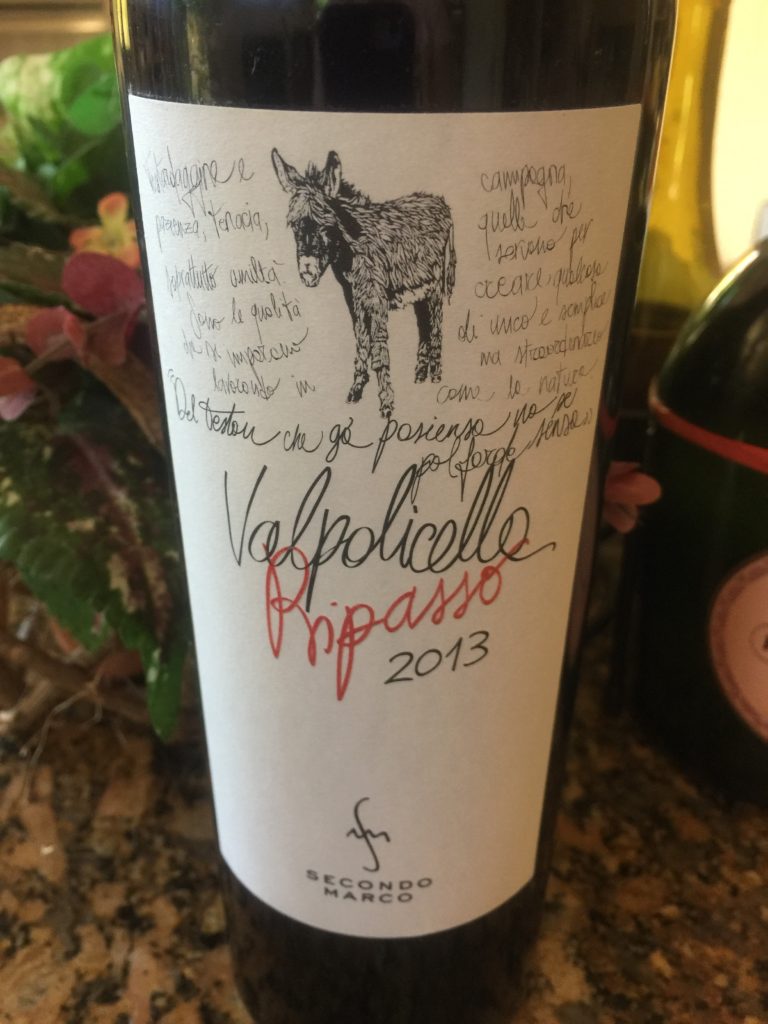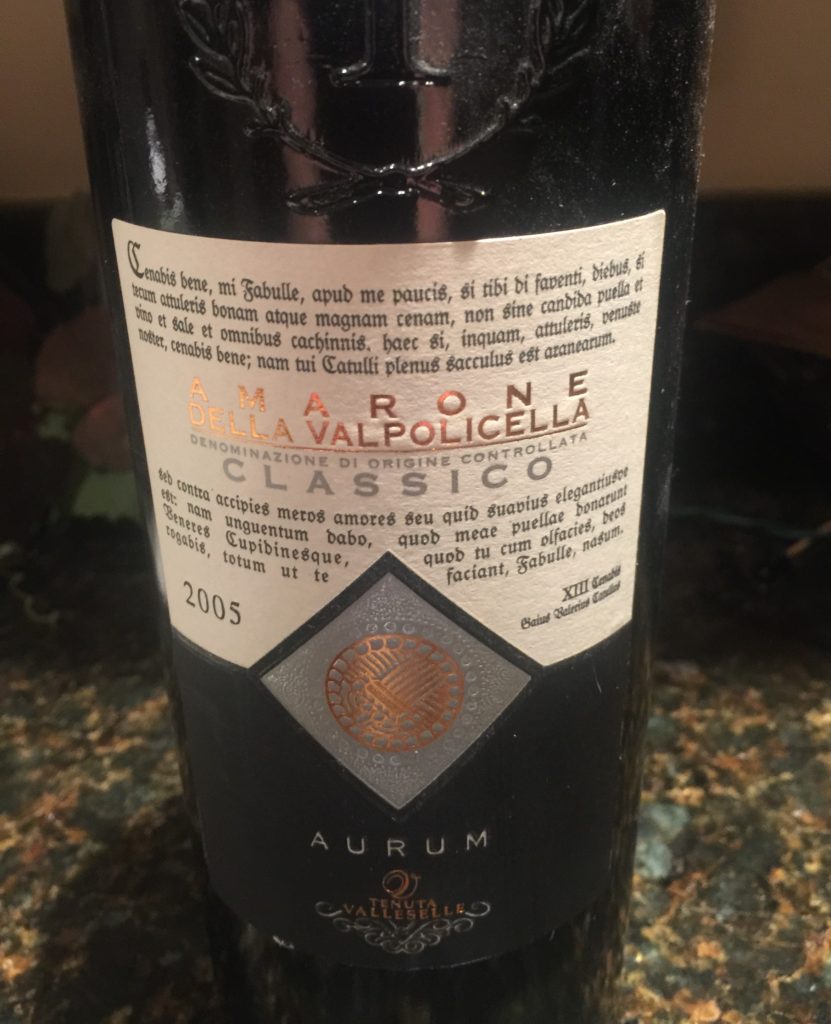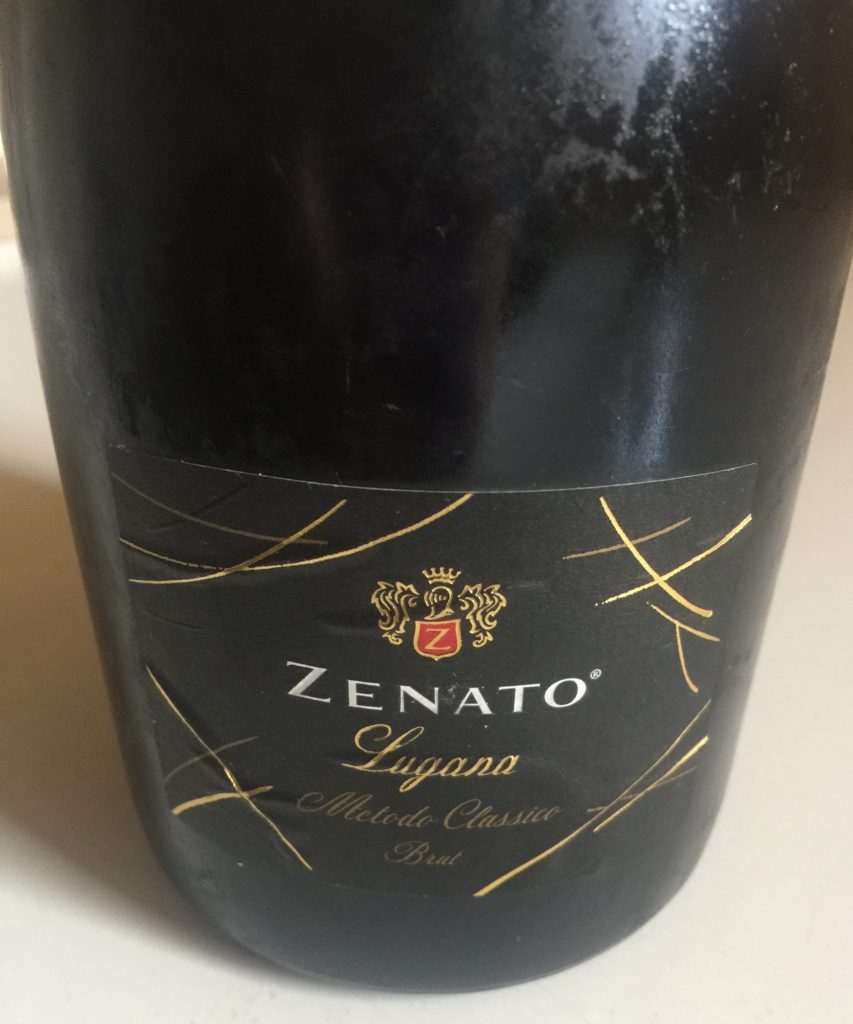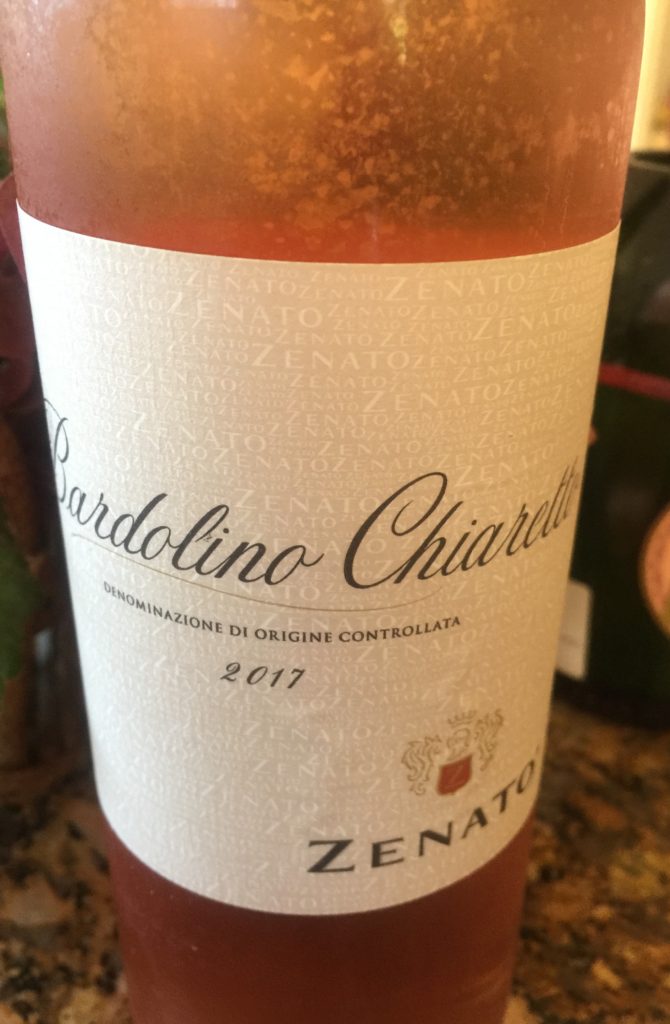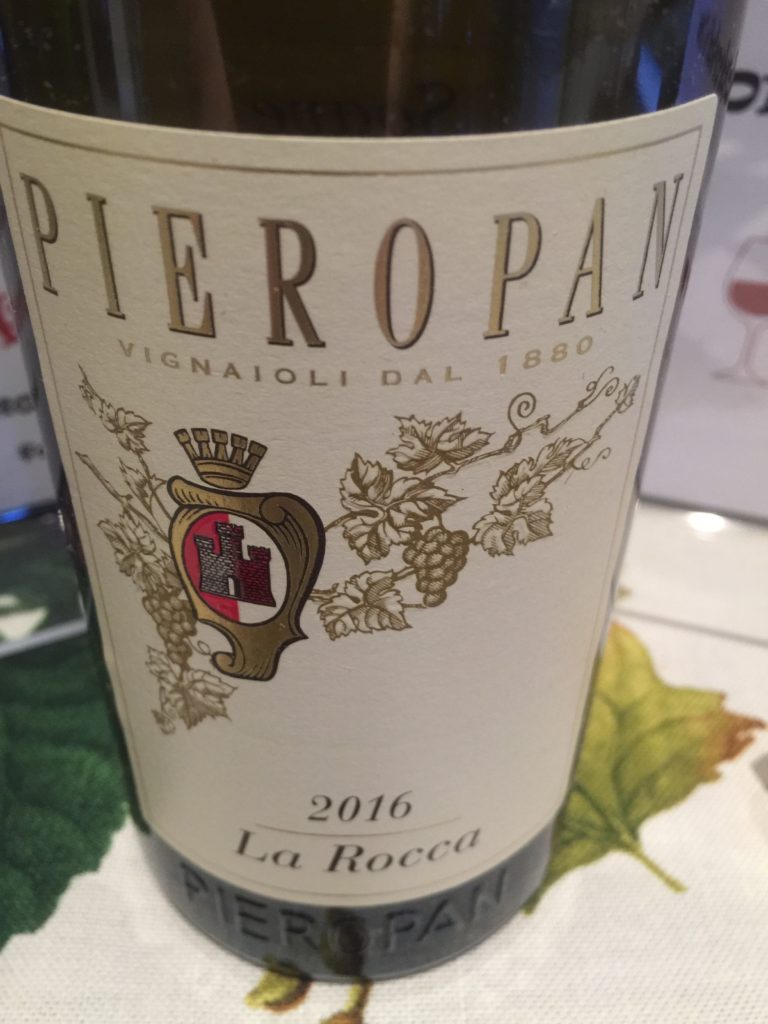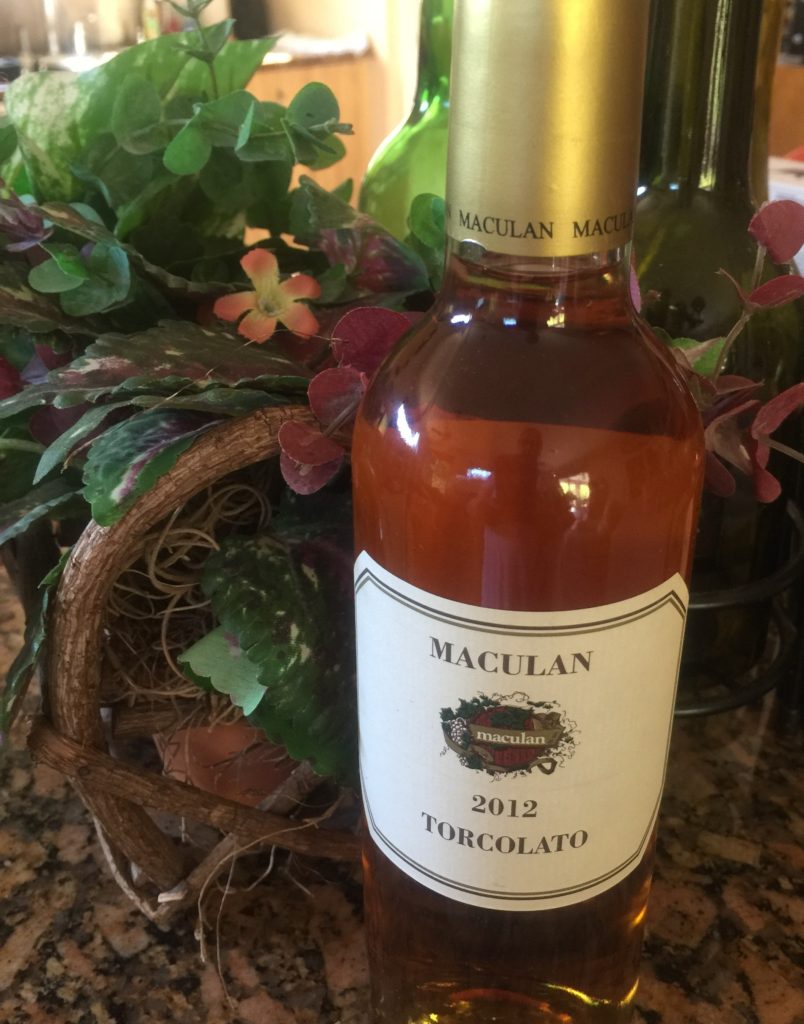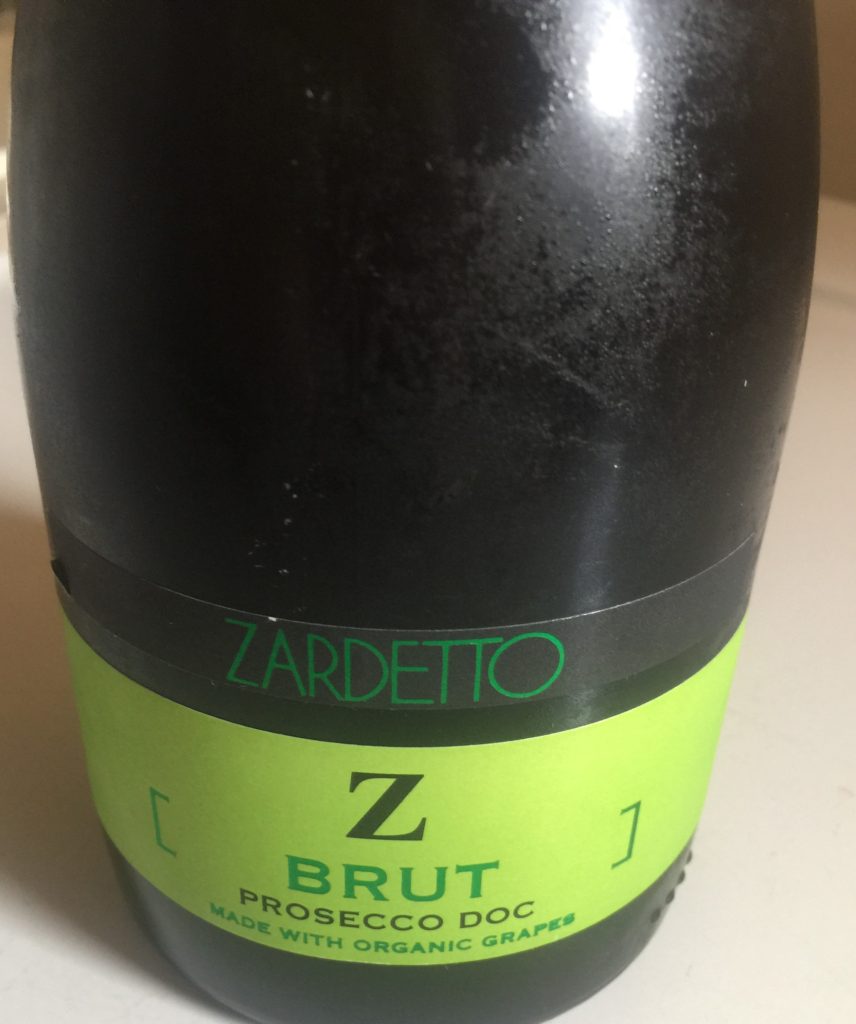There’s a little slice of heaven – white wine heaven, that is – in the northeastern corner of Italy tucked in between Austria, Slovenia, the Adriatic Sea and Veneto. It’s only about 3,000 square miles in size which is smaller than the metropolitan area of Los Angeles, but my oh my is it a wine region you should know about and come to love! Just be prepared – there are seven different DOCs all with Friuli in their name.
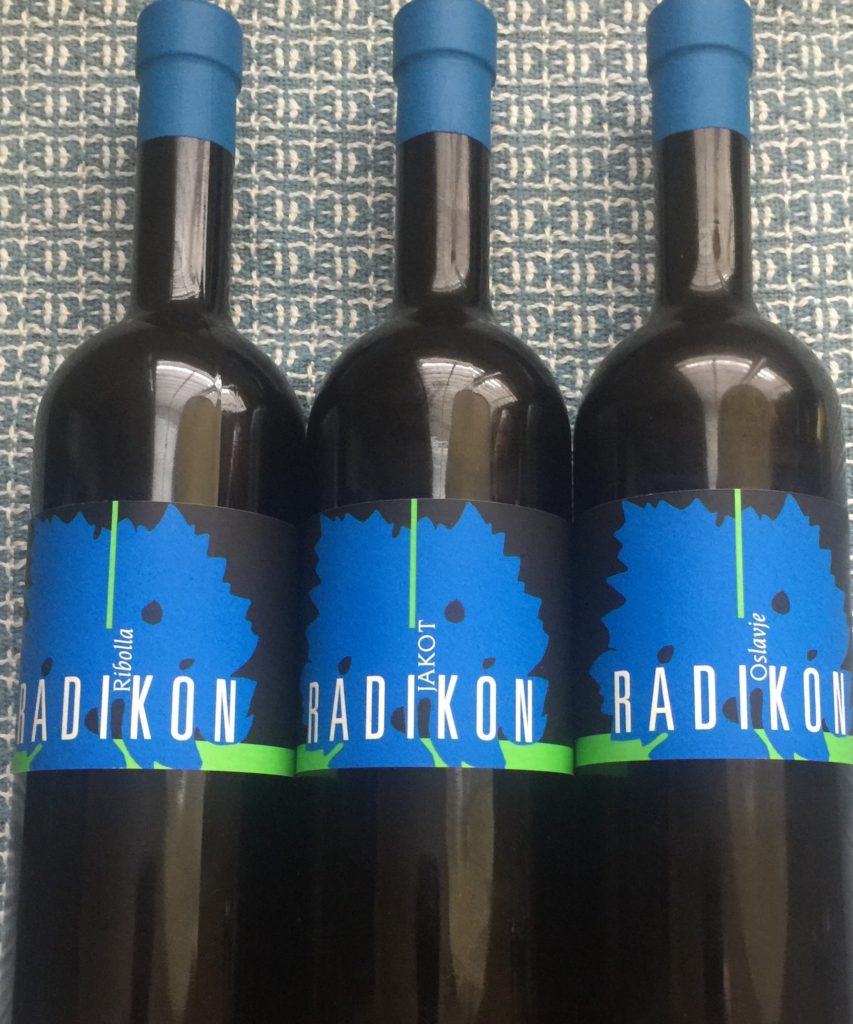
ORANGE WINE MOVEMENTS ” has a cult-like following.
Friuli Venezia Giulia (Free-oo-lee Ve-ne-tsyah Joo-lyah) or often referred to just as “Friuli”, produces some of the best aromatic white wines in Italy and some other countries in my opinion. This is a very quiet region, no big palatial villas or estates like some other regions – just a lot of small farmer producers making outstanding wine. While the tourists are all in Tuscany, you could be here tasting authentic wine made by quality-driven winemakers using unconventional methods.
Many years ago Friuli was the Mediterranean port province of the Austro-Hungarian Empire, becoming part of the country of Italy in 1866. Even today, Friuli seems to have more of a resemblance to Austria than Rome. There is significant Slavic and German influence due to the geographic location, and even though Venezia is in the name, Venice is not a part of this province. About 1.2 million people call Friuli home. There are also a number of large enterprises here such as Fincantieri (builder of some of the world’s largest cruise ships), Zanussi-Electrolux (electrical appliances) and Illy coffee. The port of Trieste plays a key role with trade in northern and eastern Europe.
Friuli is also cross-cultural land. Slovenia is right next door. In fact, the borders between Slovenia and Italy changed so many times throughout history, people who live there used to have trouble keeping up with what country they were in! Many of the same grapes grow on both sides of the border. Some of the vineyards actually cross the border.
The Pinot Grigio, Sauvignon Blanc and Ribolla Gialla are excellent here, but the Friulano grape is to Friuli like Cabernet is to Napa. White wines here have even been compared to those of Alsace and the Loire Valley. Even though white wines have become so successful, there are some excellent reds. In fact more than 40% of the region’s wines are red. Red wines in Friuli used to be single varietal with little body and not designed for cellaring. Now winemakers are making some very good red blends, often aged in oak barrels, giving depth and complexity that ensures they can age. Most of this is Merlot, but there are three local red grapes that stand out: Schioppettino, Tazzelenghe and Pignolo. Two of Italy’s most exquisite sweet wines are made in Friuli: Verduzzo di Ramondolo and Picolit.
Friuli is also known for its quantity of premium wines produced – wines with DOC and DOCG designation make up almost two-thirds of the total. And you can expect to pay more for those successful whites of Friuli than other Italian whites. That is due to vineyard yields being some of the lowest in Italy. Winemakers here are on a quest for high quality over quantity.
The grapes and wines of Friuli
Since the Alps form the northern border of Friuli, the northern half of the region is very mountainous. This leaves the southern half of the region to claim most of the vineyards amounting to about 50,000 acres. Most of the vineyards are on the plains going inland from the Adriatic Sea and they do make some great wine on the plains, but if you are looking for the very best grapes, head for the hills – the Alpine foothills, to be exact. Two of the most prestigious wine districts are Colli Orientali del Friuli and Collio (Collio Goriziano), and they are in far eastern Friuli almost to the Slovenian border. The soil here is well drained, calcium rich and sandstone. The terraced hillsides are called ronchi or ronco for singular. Ronco is often the first word of the name of a vineyard or wine estate. Colli means “small hills” and Colli Orientali refers to eastern hills. Once again – the very best vineyards are on the south facing slopes of those Alpine foothills where they get the most direct sunlight and night-time cool breezes from the Adriatic Sea.
There are four provinces of Friuli. Here is how they are divided:
Udine is in Mideast Friuli bordering Austria on the north, Slovenia on the east and the Adriatic Sea on the south. You can go to the beach here at Lignano Sabbiadoro or you can go skiing in the Alps at Forni di Sopra. Grapes grow in the southern half of Udine.
Gorizia is located in southeast Friuli bordering Slovenia and the Adriatic Sea. It is a very small area showing the influence of Germanic, Slavic and Latin culture. Here you will find the Karst plateau with calcareous rock and rocky terrain, the scene of some terrible battles during WWI and the Collio, a series of vine covered hills and home of some of Friuli’s most outstanding wine.
Trieste is the capital and largest city of Friuli. The province is situated towards the end of a narrow strip of land in the southeast, between the Adriatic Sea and Slovenia. It is characterized by steep karst, rocky moors and inland hills with hollows and scrubs. The Habsburg influence is quite noticeable in the city of Trieste, and it is a major tourist area.
Pordenone can be found in western Friuli bordering Veneto. It’s between the Carnic Alps and a wide valley between the Tagliamento and Livenza Rivers. You can see signs everywhere of its very complex history, local food traditions and a wide variety of wines.
The grapes
Over 30 different grapes varieties are grown here including local plus international grapes, but the Friulano grape is the most well-known and important of all. This is the land of the varietal – 17 different grapes are permitted to be bottled as “varietals” which means that the name of the grape on the bottle is what you will taste! That does not mean you can’t find good blends, too.
Local varieties
WHITES
White wines generally have a pear or apple aroma, range from light to medium bodied, have an acidic undertone and are very fresh and fruity.
Friulano (free-oo-lahn-oh): Makes crisp floral wine (9% of production) with notes of nuts and fennel as it ages. Tocai Friulano is now commonly known as just Friulano following a European court ruling to avoid confusion with Hungarian Tokaj. The wine mixes fruit flavors with hints of almond and citrus.
Glera: Once named the Prosecco grape, the name was changed to Glera in 2009 when Prosecco di Conegliano-Valdobbiadene was promoted to DOCG status in the Veneto. It was decided that the name “Prosecco” should be reserved for wines produced in Italy’s official Prosecco appellations, and not for the name of the grape itself. Just to complicate the situation even further, Glera/Prosecco is actually several varieties. The three key forms are Prosecco Lungo, Prosecco Tondo and Prosecco Nostrano now all legally changed to Glera. And some more complications – Glera goes by local synonym Serprina in the Colli Euganei. In any case, no matter what you call it this green-skinned grape has been growing here for hundreds of years.
Picolit: Is used to make interesting rare and elegant dessert wines that are floral with a dry finish. Picolit is prone to diseases and mutations which cause the vine to lose flowers and grape clusters. Often less than half of a vineyard will survive and be able to make wine which increases its demand.
Pinot Bianco (Pinot Blanc): Often blended with Chardonnay but makes good wine on its own.
Pinot Grigio (26% of production) (Pinot Gris): Well-made Friuli Pinot Grigios are known for fuller body and delicate peach, almond and green apple flavors. There’s an entire DOC for them!
Ribolla Gialla: These are full bodied grapes grown in Rosazzo and Gorizia regions. First written documentation of Ribolla Gialla was in 1289. This is a very acidic grape once used primarily for blending until winemakers started to use malolactic acid and other techniques to make a softer more buttery wine with a floral, acidic, fresh, fruity flavor. Mature wine has distinctive nutty taste. This aromatic delicious exotic wine is very important in Friuli.
Verduzzo: A very special native grape that makes a wine with peach and nutty flavor with more honey flavors as it ages. It works well in sweet wine production and is often dried to make passito wine, the most important dessert wine being Verduzzi di Ramandolo.
Vitovska: This is a hearty rugged vine found mainly in the Carso region near the Slovenian border where it is often compared to Albarino if not made in the orange style. It makes an elegant dry white that is briny and citrus-driven with strong minerality and snap.
RED
Nearly 40% of production is from red grapes with Merlot being the leader. The reds are typically light bodied and fruity as most of them don’t rely on aging and oak.
Pignolo: A grape from the Middle Ages; found in Udine countryside and was almost extinct. Today it’s a tasty red wine with elements of cherry flavor. You can find it at the vineyards of Abbazia di Rosazzo, one of the oldest abbeys in Friuli.
Refosco: Also known as Terrano; a versatile red grape that takes well to aging in oak.
Refosco dal Peduncolo Rosso: Best known local red; different from regular Refosco and makes an herbal bodied wine that ages well.
Schioppettino (“gunshot”): Makes a dry red wine with aromas of violets and red berries, spicy, earthy taste. Early mention of Schioppettino can be traced back to 13th century; then it was almost erased by phylloxerra and wars. By 1960s, the number of vines was less than 100 until Paolo Rapuzzi’s Ronchi di Cialla winery brought it back to life. This is the most sophisticated local red variety.
Tazzelenghe: A native grape meaning “tongue cutter” due to its high acidity levels and prevalent tannins; production is very limited to areas around towns of Buttrio, Manzano, Rosazzo and Cividale. Wines are bright, fresh and fragrant with aromas and flavors of violets, blackberries and currants.
Terrano: A genetic relative of Refosco dal Peduncolo Rosso and produces wines that are deep colored, fresh and bright with blueberry and blackberry flavors with high minerality. This is a grape you will typically find in Carso.
International grapes
Cabernet Franc: The second most popular red variety in Friuli.
Cabernet Sauvignon: Usually makes lean tight wines.
Carménère: Carmenere is considered one of the original six red grapes of Bordeaux. Now you don’t find it so much in France, but its many other places including Friuli and the eastern Veneto. It was authorized in 2007 to be used in those Italian DOC wines, but since 2009 it has been permitted to be specified on the wine label.
Chardonnay: It’s an important grape in Friuli.
Franconia: Known as Blaufränkish in Austria where it is the second most popular red grape. It is also grown in Germany (Lemberger), Hungary (Kékfrankos), Serbia and Slovakia (Frankovka) and other eastern European countries as well as the US. In Italy it’s used in a variety of DOC wines and is called Franconia. It is a black skinned grape that makes fruit forward wines with aromas of spiced black cherries.
Gewürztraminer: This is the German/Austrian/French/USA name associated with these grapes, but in the Friuli and Alto Adige part of the wine world, it is more often known as Traminer or Traminer Aromatico. Yes, Tramin is the name of a village in Alto Adige. They are pink skinned grapes classified as a “grey” grape since it is somewhere between a black and white grape varietal. Whatever the name, it makes opulent intense wines with exotic aromas like lychee, rose petals, Turkish delight, tropical fruits and perfume. On the palate there should be flavors of stonefruit and spice.
Merlot (15% of production): The most widely planted red grape in Friuli. The wines range in quality.
Pinot Nero: The Italian name for Pinot Noir and is primarily found in northern Italy regions such as Lombardia, Trentino and Veneto, but it is also planted in Friuli.
Sauvignon Blanc: More like Sancerre wines with smoke, herbs, honey and hazelnut and a very popular variety here.
The wine-growing regions
Just when you think you have Friuli all figured out and know a thing or two about the region, well think again! There are now seven different DOCs or wine-growing regions all with “Friuli” in their name! Number seven – better known as “Friuli DOC” or “Friuli Venezia Giulia DOC” was established as a DOC in 2016.
Friuli is divided into 4 top wine-producing regions and has 12 DOCs and 4 DOCG areas with 3 IGPs growing some 30 different grape varieties. In 2017 Friuli produced over 18 million cases of wine and 77% of it was white. Friuli has the highest proportion of white to red wine produced in any of the Italian regions. Much of this is from small producers.
Most of the Friuli vineyards are located in the southern half of the region, including the large wine DOC regions of Collio Goriziano, Colli Orientali del Friuli, Friuli Isonzo and Carso. The Lison–Pramaggiore region is shared with the Veneto. Friuli Annia, Friuli Aquileia, Friuli Grave and Friuli Latisana are in the central and western part of the region around the city of Pordenone.
Friuli / Friuli Venezia Giulia DOC – All of Friuli
DOC #334 Friuli was added in 2016 as a region-wide denomination that did not replace any of those other “Friuli-s” but serves as an additional alternate denomination for ALL of the already existing DOCs, even including Colli Goriziano and Carso who really did not want to be included. Therefore everything in the southern half of Friuli is included – the northern half is not, being in the Alpine mountains too high for growing grapes anyway. Those include: Carso, Collio Goriziano or Collio, Friuli Annia, Friuli Aquileia, Friuli Colli Orientali, Friuli Grave, Friuli Isonzo, Friuli Latisana, Lison-Pramaggiore, and Prosecco.
The principal white grapes are Chardonnay, Friulano, Gewürztraminer, Pinot Bianco, Pinot Grigio, Ribolla Gialla, Riesling, Sauvignon Blanc and Verduzzo. Principal reds include Cabernet Franc, Cabernet Sauvignon, Carmenère, Merlot, Pinot Nero and Refosco. They can be made into white, red or sparkling wines. Most of the allowed wines under this massive DOC were already allowed in the previously existing ones. The biggest change came with the addition of a sparkling Ribolla Gialla, which was not permissible in existing DOCs. However there are some styles missing: Frizzante, Rosato and dessert wines nor provision for Superiore or Riserva, nor the lesser-known grapes Schioppettino or Tazzelenghe. It is Pinot Grigio and Prosecco that primarily contributes to the high proportion of white versus red wine in Friuli.
Delle Venezie DOC – All of Friuli, Veneto and Province of Trentino
DOC #335 Delle Venezie – the Pinot Grigio DOC – was added in 2017 and approved for the use of these principal white grapes: Chardonnay, Friulano, Garganega, Müller-Thurgau, Pinot Bianco, Pinot Grigio and Verduzzo. Pinot Grigio wines must contain a minimum of 85% Pinot Grigio grapes. The primary purpose of creating this DOC was obviously to elevate the status and quality of Pinot Grigio wines coming from this entire area of Friuli Venezia Giulia, the Veneto and the province of Trentino. About 85% of the Italian production of Pinot Grigio comes from this area. What was once the IGP delle Venezie is now a DOC! The only permissible wines are white Bianco and Pinot Grigio, and sparkling Pinot Grigio Spumante.
Prosecco DOC – All of Friuli and 5 Provinces of Veneto
Prosecco was granted its own DOC status in 2009 and applies to five provinces of the Veneto plus the entire Friuli Venezia Giula region. That is really appropriate considering the name came from the little village of Prosecco near Trieste, where the grape and wine was thought to come from. Prosecco is made from the Glera grape which must make up a minimum of 85% of all grapes used to make it. The other 15% may include local grapes Verdiso, Bianchetta Trevigiana, Perera and Glera Lunga and international grapes like Chardonnay, Pinot Bianco, Pinot Grigio and Pinot Nero (when vinified as white wine). It can only be made into a white blend or Spumante sparkling and must meet all of the regulations for grapes and percentage for use. Prosecco reigns supreme in this part of the world. Almost 37 million cases of the fizzy stuff were produced in 2017.
The two most respected DOCs of Friuli are Collio Goriziano and Friuli Colli Orientali. The standard of winemaking is very high here and yields are relatively low. There is a competition between these DOCs and the Alto Adige over who makes the most excellent fresh fruity white wines.
Collio Goriziano (Collio) DOC – Gorizia Province
Usually just known as “Collio”, this is one of the most exceptional DOCs of the region. Collio grapes are grown in the southeastern province of Gorizia and just over the hills of Gorizia on its northern border is Slovenia. Collio is almost indistinguishable from Slovenia. In fact part of the regions vineyards are actually in Slovenia, but none of the Slovenian wines can be labeled with a Collio designation. The slopes are much steeper here near the Alps foothills and the cool wind brings freshness and acidity to the grapes. Fine, increasingly fruity, interesting acidic whites are made here. The wine is full bodied and rich; with fresh flavors of apples and apricots; aroma hints of smoke, vanilla and hazelnuts. It is made as a varietal or a blend of Friulano, Ribolla Gialla, Malvasia Istriana, Chardonnay, Pinot Bianco, Pinot Grigio and Sauvignon Blanc. Red wine is designated Collio Rosso and made from a blend of Merlot, Cabernet Franc and Cabernet Sauvignon. The Collio Bianco designation can also include white grapes Müller-Thurgau, Picolit, Riesling, Traminer and Welschriesling. It can also have white juice from red wine grapes of Cabernet Sauvignon and Pinot Nero.
Collio is famous for age-worth Chardonnay and local white wine blends. Little more than 5% of Friuli wine comes from Collio vineyards but it usually receives the highest accolades and awards. There is very little if any oxygen contact during fermentation and the wines are aged longer in oak and barriques. The Sauvignon Blanc, Chardonnay and Pinot Grigio are generally more concentrated and powerful and can easily reach 14.5 ABV.
The Collio Bianco is a general term referring to a white blend entirely of the producer’s choice. Collio wines pair perfectly with savory first courses or to Frico (free-co) a cheese tart and one of the signature dishes of Collio. Prices are higher for Collio wine ($20 – $50).
Colli Orientali del Friuli DOC– Udine Province
(Co-lli Oryen-tally) Orientali extends northwest of the Collio Goriziano along the Slovenian border to Tarcento and east of Udine (oo-den-eh) where winemaking dates back to Roman times. As we said before, the best wine comes from the hills, and there are plenty of them here. After all, Colli means “hills”. Ribolla Gialla, Picolit and Verduzzo play an important role growing right next to Sauvignon Blanc, Chardonnay and Pinot Grigio. This is a great area for white wines – they do really well here. The hillside vineyards have a mix of clay and stones which is a wonderful terroir for whites; reds also do well in the calcium-rich terraces. There is a lot of stone fruit, white flowers and ripe apples with long finish on these wines.
Local varieties are the most important: Friulano is the signature grape of the region. Taste one of these and you’ll get notes of thyme, apricot, Meyer lemon, and ripe gooseberry with a bitter almond finish.
Ribolla Gialla (Jal-la) is high acid, rich and full of apricot, tangerine and Asian pear flavors. And then there is Malvasia which is often made into aromatic dry wines. Picolit has 2 DOCGs in Orientali dedicated to producing dessert wine.
Red wine is more prominent in this region although it’s still less than half the production of white. Reds include Merlot, Cabernet Franc, Cabernet Sauvignon, and the local Pignolo, Refosco, Refosco dal Peduncolo Rosso, Schioppettino and Tazzelenghe. The best reds are from the south-western corner of Colli Orientali which is in the foothills of the Dolomites and mostly alpine.
Yes, you may consider wine prices to be higher here, but they age longer and are usually more complex. The wines pair well with their local Prosciutto di San Daniele (similar to Parma) and other regional cold cuts, risottos and seafood.
Bastianich Winery
The Bastianich’s have been connected to winemaking families since the 1970 and 80s, and have promoted the wines of Friuli in their restaurants in New York City and beyond. Eventually they decided to create great wines in their own vineyards by acquiring 90 acres of Bastianich vineyards in 1997. The original vineyard is located in in the southernmost zone of the Friuli Colli Orientali in the communes of Buttrio and Premariacco. The terraced vineyards were replanted and reterraced in 2000-2002. Now at the height of quality production they grow the grapes for Vespa Bianco, Vespa Rosso, Plus and Calabrone wines. The vineyards in Cividale, just 10 miles north produce the grapes for the fresh aromatic Vini Orsone wines. Just in case you missed it, the Bastianich family is quite famous with their restaurants, cooking shows, and cook books!
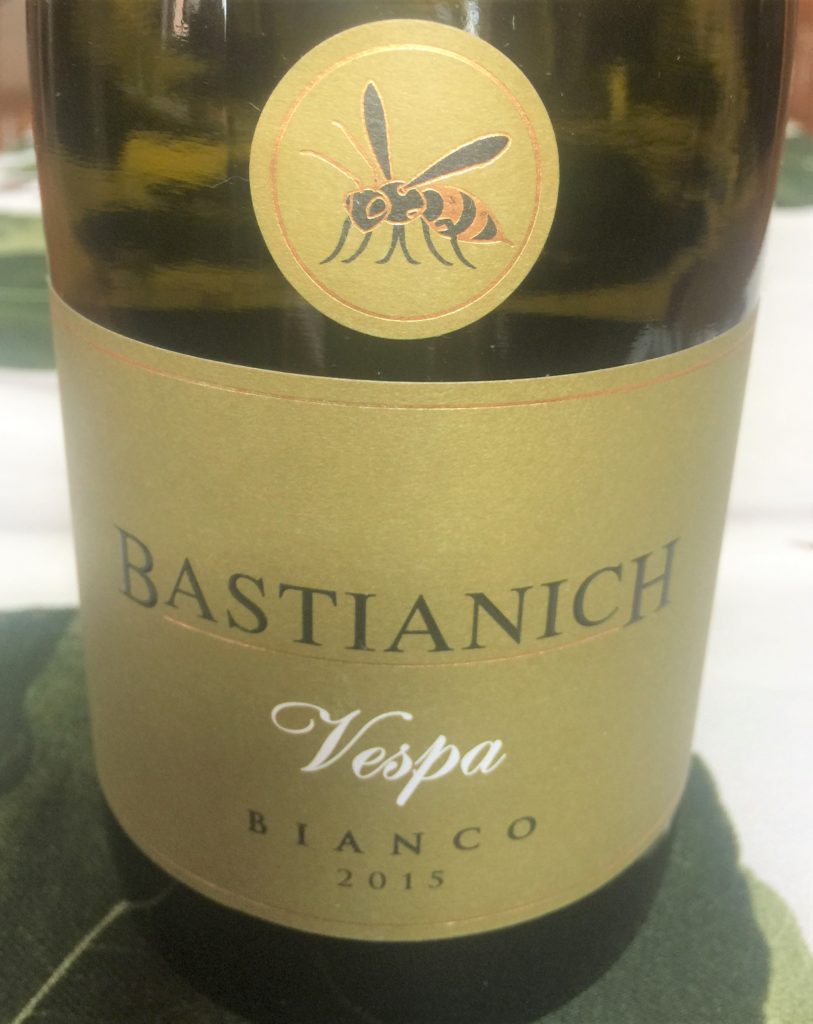
Bastianich Vespa Bianco 2015 IGT Venezia Giulla (Colli Orientali)Bastianich “Vespa” IGT Venezia Giulla is the flagship wine of the estate and was born with the winery in 1998. It’s a blend of Chardonnay and Sauvignon Blanc – the Chardonnay gives it elegance and the Sauvignon Blanc gives it structure. This “super white” is considered one of the best white wines in Italy. When young it has nuances of yellow and gold hues, with brightness and clarity. On the nose you will find hints of beeswax, apricots and honey. It is complex, rich and balanced on the palate. You can age it for 5-10 years or more. Vespa Bianca is fermented 50% in stainless steel and 50% in oak casks of either 500 or 4000 liters. 13.5% alcohol.
Orientali is further divided into 3 DOCGs, two of which make sweet wine. You will definitely pay the price for these wines – if you can find them!
Ramondolo DOCG – Udine Province
One of the best known wines of Friuli is made here. It’s a white sweet dessert wine made from 100% native Verduzzo grapes grown on hills north of Udine, and the first to be awarded this status. After receiving DOCG status in 2001 the Ramondolo name can only be used for wines made in Nimis and Tarcento in Udine. This is a late harvest wine made by drying the grapes in racks; some years even undergoing Botrytis. The wine is an intense golden yellow color, intense aroma, sweet velvety tannic and full-bodied taste with a possible hint of wood.
Colli Orientali del Friuli Picolit DOCG –Udine Province
Picolit is a sweet dessert wine made of Picolit grapes. It has an intense golden color, distinctive aromatic sweet scent, delicate honey flavor and sometimes hints of wood from two years in the barrel. The Picolit grape is named after its tiny yields (“piccolo” means small), is very difficult to grow and very delicate requiring harvest by hand. This wine is generally consumed as a “meditation” wine – vino da meditazione -which means it is to be enjoyed without food after the dinner table has been cleared. Expect to pay $100 for the meditation. This was one of Friuli’s first internationally successful wines and at one time was bottled in handmade Murano glass. Picolit first became a DOC in 1979 without much success until it was elevated to DOCG in 2006.
Colli Orientali del Friuli Cialla DOCG – Udine Province
The specific location of “Cialla” will appear on Colli Orientali del Friuli Picolit DOCG wine produced in the “Cialla” prestigious parish subzone. Here you will find Cialla Bianco Picolit and Riserva made from 100% Picolit and with 16% alcohol.
The Ronchi di Cialla estate was founded in 1970 by the Rapuzzi family. Cialla is a small valley in the Colli Orientali del Friuli area officially recognized with a Ministerial Decree as Cru CIALLA only for the cultivation of native wines from Friuli: Picolit, Ribolla Gialla and Verduzzo for whites and Refosco dal Peduncolo Rosso and Schioppettino for reds. The Rapuzzis won a prestigious award in 1976 for saving the Schioppettino vines from disappearing. They found about 70 surviving grapevines in the valley and bottled their first vintage – 35 hectoliters – in 1977. Ronchi Di Cialla is now certified by the World Biodiversity Association and they remain committed to using natural practices. They work with relatively low yields of 115,000 bottles per year from a 28 hectare estate. Picolit di Cialla comes from about 2 hectares, spends 12 months in oak barrels and 24 more months aging in bottles.
Colli Orientali del Friuli Rosazzo DOCG – Udine Province
Rosazzo is an elegant, fruity, floral dry white wine made from a blend of Friulano, Sauvignon Blanc and Pinot Bianco and/or Chardonnay grapes. The Rosazzo DOCG is in the province of Udine and includes Manzano, San Giovanni al Natisone and Corno di Rosazzo. The Abbey of Rosazzo was built in Manzano around year 1000 and is surrounded by vineyards that were in use during the Middle Ages. The Monastery was founded by the Augustinians, held for a long time by the Benedictines, and then by the Dominicans. It’s a religious center but also a major reference point for winemaking in Friuli. The Abbey was restored and completely reopened in 1995 for worship. The Sdricca wine route takes you right through the abbey’s grounds.
Friuli Grave DOC – Udine and Pordenone Provinces
Friuli Grave (Free-oo-lee Gra-veh) is a very large agricultural area in the center-west accounting for more than half of the production and became a DOC in 1970. The valley is made up of flat land with very stony soil. The stones get hot during the day and cold at night which is a great thing for ripening those grapes. Pinot Grigio and Prosecco reign supreme here. You can also find red wines made from grapes such as Cabernet Sauvignon, Merlot and Refosco dal Peduncolo Rosso. Friuli Grave white wines are great with sushi, veggies and light cheeses or alone as an aperitivo. Wines are light and zesty; gentle herbaceous notes, citrus-like aromas and high acidity. Drink them young (2-3 years). Prices are $10 – $15 compared to Alto Adige; a good value!
Friuli Isonzo DOC – Gorizia Province
Isonzo is located in far southeastern Friuli bordering Slovenia along the Isonzo River and receives a greater warming influence from the Adriatic Sea. This region is known for its sparkling Pinot Bianco and dry white wines made from Chardonnay, Malvasia Istriana and Sauvignon Blanc. It also produces excellent quality dry, off dry and sparkling wines from Gewürztraminer, Moscato Gialla, Pinot Grigio, Riesling, Friulano, Verduzzo Excellent reds are made from Cabernets, Refoscos and Pinot Nero as well as sweet Vendemmia Tardiva late harvest wines as either single varietal whites or blends.
Carso DOC – Gorizia and Trieste Provinces
Carso is south of Isonzo and in the hills near Trieste (tree-est-the). It is on the Istrian Peninsula and makes excellent red Terrano wines plus highly regarded Malvasia Istriana whites. Other grapes are Vitovska, Cabernet Franc, Cabernet Sauvignon, Chardonnay, Merlot, Pinot Grigio, Sauvignon Blanc, Traminer and Piccola Nera.
Carso is quite small and most famous for its orange wine. Yes, the same “orange wine” that forkandcorkdivine talked about and served for our wine dinner experience in Slovenia. No, the wine is not orange! It is made by letting the juice of white grapes keep in contact with the grape skins during fermentation, a process typically used only for making red wine. Flavors of orange or “amber” wine range from dried fruit to tea-leaves and sweet spices with a touch of nutty oxidation. Wines from Carso are high in acidity with interesting mineral tones, soft tannins and a long tart tingly finish. They are also oxidized which allows them to be stable enough to age longer. It is best to decant an orange wine from Carso for several hours before serving. Carso orange wines are made from Pinot Grigio, Ribolla Gialla, Malvasia, Vitovska or a blend of the winemaker’s choice.
The red wine called Terrano tastes of cherry fruit and forest floor with moderate tannin and very high acidity. This grape is often confused with Refosco, but you will only find Terrano in Carso and just across the border in the Kras region of Slovenia. Terrano wines pair really well with Slavic cuisine.
Some lesser known Friuli DOCs to the south and you can find good wines in all of them.
Friuli Annia DOC – Udine Province
Annia is a small DOC established in 1995 including the coastal vineyards around the Lugana di Marano. The lagoon is a big help to the terroir here – it takes the heat out of summer afternoons and frost out of winter mornings. The typical grapes of this area make white, Rosato, red and sparkling wines. Over 7000 cases were produced in 2016.
Friuli Aquileia DOC – Udine Province
Aquileia has a maritime climate due to being in the lowlands by the Adriatic Sea. The soil is excellent for viticulture and the wines have exceptional distinctive aromas. Wines here are a little less structured and meant to be drunk young. Aquileia was established as a DOC in 1975 for the commune of Aquileia and 16 communes in the province of Udine. They make white, Rosato, red and sparkling wines and produced over 250,000 cases in 2016.
Friuli Latisana DOC – Udine Province
Latisana was also established as a DOC in 1975 and consists of 170 plus acres of vineyards on the Adriatic coast. Annia is to the east, Grave to the north and the Lugana di Marano on the south. The alluvial sandy clay soil here is excellent for viticulture. Latisana produces white, rosato, red and sparkling Spumante and semi-sparkling Frizzante wines. Passito and Superiore and Riserva Passito wines can also be made here. Just under 25,000 cases were produced in 2016.
Lison-Pramaggiore DOC – Pordenone Province….and Venice and Treviso (Veneto)
This is a DOC originally created in 1971 in the Veneto wine region which merged in 1985 to include the Chions, Cordovado and Pravisdomini communes in the Pordenone Province of Friuli. Lison and Pramaggiore joined forces to reflect the future needs of Italian winemaking and marketing. Lison-Pramaggiore Bianco is based on the Tocai Friulano grape, now known as Tai to avoid confusion with Tokaj wines of Hungary. The final blend must be 50-70% Tai. Lison-Pramaggiore Rosso must be 50-70% Merlot and can be a Riserva if aged for two years. They also grow the Bordeaux grapes plus Pinot Nero and Refosco. Other whites include the Pinots Bianco and Grigio, Verduzzo, Riesling, Chardonnay and Sauvignon Blanc. They also make sparkling and dessert wines. The DOC produced over 147,000 cases in 2016.
Lison DOCG – Pordenone Province….and Venice and Treviso (Veneto)
Lison was upgraded to a separate Lison DOCG in 2011 with a Classico subzone and makes a white Bianco blend of 85% Friulano.
Friuli Venezia Giulia IGT/IGP wine appellations
There are three IGT (Indicazione Geografica Tipica) or IGP (Indicazione Geografica Protetta) that include Friuli since the elevation of IGT Delle Venezie to DOC in 2017. They are Alto Livenza, Trevenezie and Venezia Giulia. “IGT” is a wine classification introduced in 1992 as part of the DOC (Denominazione di Origine Controllata) Italian wine laws. Its official purpose was to create a category for wines that don’t meet the DOC requirements but have regional character, and unofficially to squash the revolt by big name producers who didn’t want to follow the DOCs, and especially didn’t want their wine to be labeled as table wine (Vino da Tavola)!
Alto Livenza IGT – Pordenone Province and Treviso Province of Veneto
This cross-regional wine producing area was officially created in 1995 to include one province of Friuli and one in Veneto. The defining factor for this geographical area is the Livenza River which crosses through it. This was the first Italian district for furniture production; it has also been famous for its wines which were labeled “Alto Livenza” since 1977. Wines are permitted in the following styles: White Bianco (blends) dry and frizzante; Rosso dry, frizzante and Novello; Rosato dry and frizzante. They are made from these grapes: Chardonnay, White Manzoni, Malvasia Istriana, Müller-Thurgau, Pinot Bianco, Pinot Grigio, Glera, Italian Riesling, Sauvignon, Gewürztraminer, Verdiso, Verduzzo, Tai, Marzemina Bianca, Cabernet Franc, Cabernet Sauvignon, Franconia, Malbech, Marzemino, Merlot, Petit Verdot, Pinot Nero, Raboso, Refosco, Carménère, Syrah, Rebo and Manzoni Rosé. It is interesting to note that none of the wines can contain more than 80% of the main grape variety – thus NO varietal wines permitted under this IGT.
Trevenezie IGT – All of Friuli, Trentino-Alto Adige and Veneto
This geographical area was originally established as IGT delle Venezie in 1995 but renamed when Delle Venezie DOC was split off in 2017. It is the same zone as the old IGT and the new DOC. There are many Italian and international grapes permitted; however the exact list varies by province. IGT Bianco, Rosso and Rosato wines are allowed to use any proportion of permitted grapes. Those labeled as Varietal must have at least 85% of that grape on the label. Wines can also be labeled in Slovenian as Tri Benečije. Over 12,000 acres of vineyards are included with production well over 18 million cases in 2016. It’s hard to tell how much wine will continue to be made under this classification since the new Delle Venezie DOC focuses on Pinot Grigio which used to account for a major part of production here.
Venezia Giulia IGT – All of Friuli
Venezia Giulia was established as an IGT in 1996 and includes over 7000 acres. It produced 1.3 million cases of wine in 2016. You will find these principal white grapes: Chardonnay, Friulano, Gewürztraminer, Glera, Malvasia, Manzoni Bianco, Moscato, Pinot Bianco, Pinot Grigio, Ribolla Gialla, Riesling, Sauvignon Blanc, Verduzzo, Vitovska and Italian Riesling. Red grapes are: Cabernet Franc, Cabernet Sauvignon, Franconia, Merlot, Pinot Nero, Refosco, Schioppettino and Terrano. Bianco, Rosato and Rosso wines can be made from any proportion of grapes approved for the region; varietal requirements are indicated by province. There are specific requirements for dual varietals. For example: Chardonnay and Pinot Bianco or Sauvignon Blanc must contain 50-85% of first-named variety and 15-50% of the other. There are no minimum aging requirements.
Winemaking in Friuli
Winemaking didn’t get much attention in Friuli after the scourge of phylloxerra until the 1980s and 90s international popularity of Pinot Grigio. Prior to that, vineyard owners sold their grapes to co-ops and négociants who blended all of the grapes together, and sold their mass-produced wines for local consumption. Thanks to some Friulian producers like Mario Schiopetto, Livio Felluga, Collavini, Pasini and Dorigo, their commitment to make high-quality wine that highlighted the grapes and then sell it all over Italy was an entirely different business model. Mario Schiopetto gained a lot of technical knowledge and expertise from some German winemakers, then put it into practice and made wines that were unbelievable to other Friulian winemakers. These were clean, clear lively wines with enticing up-front fruity aromas. This was the beginning of the first modern-style whites to be made in Italy. How did Mario do it? He used temperature-controlled stainless steel tanks for fermentation, pneumatic presses and more reliable laboratory produced yeast strains. In 1965 Mario brought out his first “Tocai” thus giving birth to the era of modern white wine making in Friuli. He transformed the future of white Friuli wine forever. It took a while for his innovations to be accepted, but eventually he became part of a group of Collio producers that worked together to improve and modernize Italian wine production. With Mario’s success at producing, bottling and marketing the product of his own vineyards, other farmers and vineyard owners decided to follow suit and began to open their own small wineries. Friuli had survived two world wars, famines, population drain, poverty and a major earthquake and now was about to latch onto winemaking as an opportunity to save the region.
So it seems that winemakers in Friuli are known for being forward-thinking and pioneers of modern techniques during this first revolution of Friuli winemaking, but there is quite a different other side to this story. Without access to all of these modern techniques and laboratory products for avoiding oxidation and controlling fermentation, winemakers had to rely on the “old ways”. One of them in particular was “long skin maceration”. It was quite common in the Collio area and Slovenia to macerate white wines on their skins for days and or even weeks. Here are some of those history-making pioneer winemakers.
Joško Gravner – Collio
The leader in the second revolution of Friuli winemaking was Jožef Gravner to be followed by his son, Joško who many consider to be the father of modern day amber, orange macerated winemaking. A group of winemakers with similar interests including Stanko Radikon and Edi Kante gravitated to Joško Gravner between 1985 and 1999. Gravner and their wines reaped many praises. However Gravner now wanted to go back to the roots of winemaking in Georgia where wine has been consumed for 8000 years and where wine was made in qveri or Georgian amphorae. He started fermenting white grapes on their skins just like his father and grandfather had done before the new wave of modernization came to Italy. In 1997 he managed to get a terracotta qveri vessel from Georgia, made an experimental batch of wine in it that fall, and he was so happy with the results that he started selling off his stainless steel tanks and began to make skin macerated wines. These wines were quite different from anything else being produced – dark amber in color, slightly hazy since they were unfiltered, but with wonderful aromas of spice, herb and honeyed fruit. The Collio “wine police” failed to consider these wines as meeting Collio DOC regulations and in 1998 downgraded them to IGT Venezia Giula status. Gravner’s wines were not accepted and by 1998, he broke off from his colleagues. Today Gravner’s wines are some of the most highly sought out from Collio. Josko also decided that Ribolla Gialla was his favorite and the best grape, producing his last vintage of Breg in 2012, a white blend of Chardonnay, Sauvignon, Pinot Grigio and Italian Riesling. The Breg will be sold in 2020. Now he concentrates on Ribolla Gialla. The Breg and the Ribolla Gialla are both made with about six months skin contact in qveri and released after seven years ageing.
Stanko Radikon (Collio)
Stanislao “Stanko” Radikon has a family home and winery just 400 meters up the hill from Gravner in the town of Oslavia near the border of Slovenia. There are just 27 acres of vines. Radikon took over his family vineyard in 1979. Radikon and Gravner worked together closely for two decades before they parted ways. Radikon made his Ribolla Gialla in the new modern way until one day he decided the wine lacked the flavors and aromas that the grapes were so known for. It was then that he decided to try making the wine just like his grandfather did 50 years before – he put some grapes in an oak barrel and left them to ferment for a week on their skins. The resulting wine was such a revelation that he decided to convert his entire production of whites to skin maceration, just like Gravner sometime during that same year. He continued to experiment and eventually decided that two to three months was optimum. He also stopped adding sulphites in 2002 when he realized that it was no longer needed due to the long skin contact. Radikon has been making entirely orange wines since he first macerated that Ribolla Gialla in 1995. His Oslavje, Ribolla Gialla and Jakot wines are now famous around the world. Stanko died from cancer in 2016 at age 62 after making 36 vintages of wine. His son Saša is now in charge to carry on the legacy. The winery’s philosophy is still to make natural organic wine with the least human intervention possible and with maximum respect for the soils and nature. All vinification is done in Slavonian oak barrels – first in wood vats, then in large barrels in which the wines are aged for about 3 years before bottling. Radikon has cult wine status worldwide!
Radikon Jakot is made from 100% Friulano which had always been known as Tocai Friulano until the EU banned this name in 2008. It seems the Hungarians complained that it might be confused with their Tokaj wines. So what did the rebellious Radikon do? He named his Friulano wine “Jakot” which is Tokaj spelled backwards! Since then Dario Prinčič and many other winemakers have adopted the name Jakot.
Here’s another one of Radikon’s forward thinking ideas which he had together with Edi Kante. They thought that the traditional 75 cl bottle size was too much for one person, but not enough for a whole meal for two people. From my experience, he was definitely right about that! So they started bottling premium wines in 500 cl and 1 liter bottles. They needed specially made corks to make this happen. Supposedly Edi Kante jokes that “the one liter bottle is perfect for two people if only one of them is drinking”!
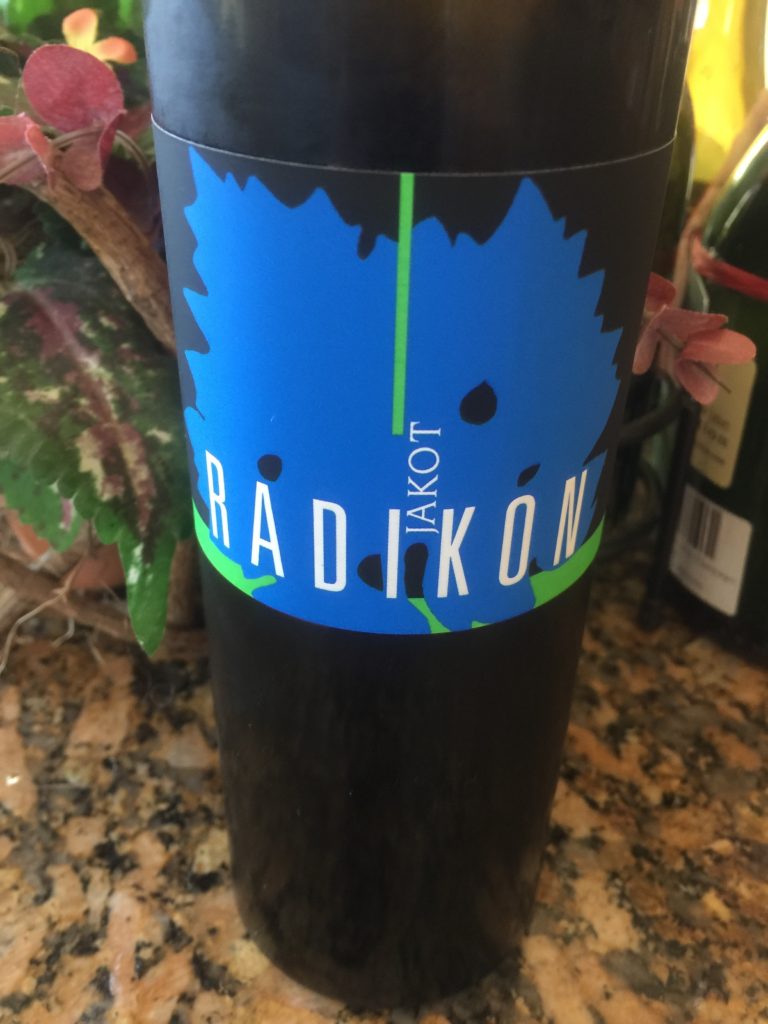
Radikon Jakot 2012, Venezia Giulia IGT (Collio)2012 Jakot is 100% Friulano orange wine that was organically farmed, hand-harvested, placed in old Slavonian oak vats and fermented with native yeasts. It macerated with skins for around 3 months with no temperature control and no sulfur. It was then racked and aged on the lees in huge Slavonian oak casks for 3-4 years, then bottled and aged for several more years. The “current” vintage is always 7 years ahead of today. We expect it to have a nose of dried fruits, flowers and minerals; elegant with huge concentration, texture and layers of flavors. And it comes in a 500 ml bottle!
Edi Kante (Carso)
Edi Kante decided that macerated white wine was not his thing, and went on from this original group of experimenters and history makers to make white wine from the stony Carso region just outside of Trieste. Today he is a well- known cult organic producer. Edi took over from his father and began to bottle the family estate’s wines separately by varietal in the late 1980s. After his experimentation with orange wine, he went on to make pure consistent wines that reflect the region. His white wines are aged in older barrels for a year, then 6 months in stainless steel on the lees, and then bottled unfiltered. All of this takes place in his incredible three-story cellar carved out of solid stone beneath his house. His red wine is made from the local grape Terrano, and Pinot Nero when conditions are favorable. He makes Metodo Classico sparkling wine as well as selezione wines released in small quantities from select vintages. They are typically aged between 8-10 years before release. A quote from Edi: “I was born on the border and I have no borders”.
Doro Prinčič (Collio)
Doro Prinčič is a 25 acre vineyard in the municipality of Cormòns in Collio. Alessanndro (Sandro) Prinčič is in charge of this tiny estate that is named after his father Isidoro, a farmer who worked hard to make this one of Friuli’s finest wine producers. Isidoro was among the first winemakers to believe in Collio wines and began bottling his first wines in 1952. Sandro is already passing along his knowledge to the next generation, his son Carlo who works with him in the cellar to ensure that his grandfather and father’s legacy continues. The vineyard is divided up into 30-odd parcels producing 60,000 bottles annually of Friulano, Malvasia, Sauvignon Blanc, Pinot Bianco, Cabernet Franc and Merlot. Sandro doesn’t use oak for his whites – he prefers stainless steel tanks; reds are vinified in 20 hectoliter barrels. Prinčič wines have lots of concentrated fruit and are slightly higher in alcohol.
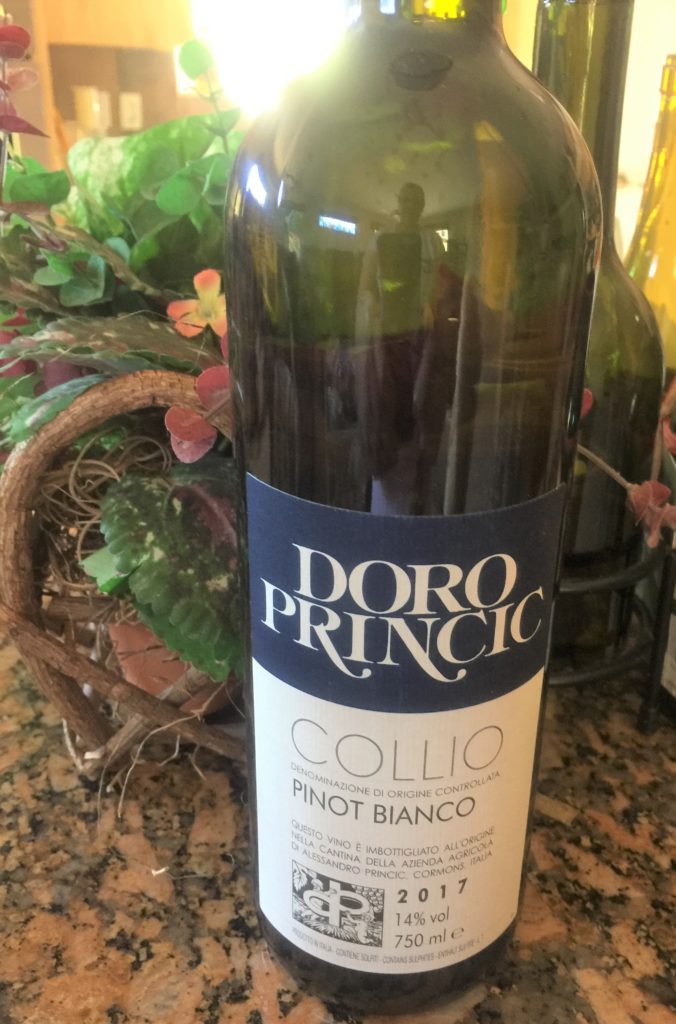
Doro Prinčič Pinot Bianco Collio DOC
Doro Prinčič Pinot Bianco 2017 Collio DOC
This is a 100% Pinot Bianco wine from Prinčič estate vineyards that was entirely vinified in stainless steel and aged for one year in stainless steel before release. The first vintage of Pinot Bianco was released in 1960. Winemaker tasting notes tell us to expect bread crust and fruity aromas of pear, lime and orange. Alcohol level is 13.5%.
Orange wine
Since the orange wines of Collio, Carso and their neighbors in Slovenia are so unique, here is the information published in the forkandcorkdivine article about Slovenia – just in case you missed it!
You have probably seen articles about orange wine for the past few years, but just in case it passed you by, here are the “quick sips and tips”. Orange wine, aka amber wine, is actually a white wine – having absolutely nothing to do with oranges – made by leaving the juice in contact with the grape skins and seeds resulting in an orange-colored wine. Juice can be left in skin and seed contact from a few days to a year. Winemakers who use this method usually tend to be more artisanal as it is a more labor-intensive and riskier way of making wine.
This non-intervention style of wine tastes different from the traditional winemaking process – it may actually taste sour and nutty. While modern day orange winemaking has only been on the radar for 20 years, it could possibly date back as far as 8000 years ago in the country of Georgia in the Caucasus Mountains where wines were fermented in large subterranean vessels called Qvevri (Kev-ree) that were closed with stones and sealed with beeswax. Winemaking in Qvevri is so unique that in 2013 UNESCO granted the status of intangible cultural heritage (ICH) to the tradition. Even though this style is still not prevalent worldwide, orange winemaking occurs frequently in Friuli Venezia Giulia, northeastern Italy; Slovenia and Georgia; some on several other continents and even a few US winemakers. If you would like to learn more about orange wine, you can read all about it in great detail in a 250 page newly published book “Amber Revolution: How the World Learned to Love Orange Wine” by Simon J. Woolf, an award winning English wine and drinks writer. “Amber Revolution” was released by Amazon.com in October 2018.
Here is some specific production information about the winemakers we highlighted in Friuli:
Radikon ferments their de-stemmed Ribolla Gialla grapes in open top Slovenian oak. It ferments naturally with the cap punched down about four times a day. The cap consists of the solid mass of skins that rise to the top. The fermenter is sealed and made air-tight when fermentation is complete, and the wine stays with its skins for three more months. Then it is racked into large oak “botti” for about four more years before bottling. (Note: A botti is a large old barrel usually made of Slavonian or Austrian oak with capacity for 100 liters or more.) After bottling, it gets about two more years before release to the market. At no time does Radikon use any sulfites and does not fine or filter the wine.
Gravner leaves the stems on the grapes, gives them a bit of sulfur, and then ferments them 100% in Georgian qveris buried in the cellar. The grapes are punched down every three hours between 5 AM and 11 PM. They do put some cardboard over the qveri open tops to keep the flies out! They are lightly sealed after fermentation is complete. The Ribolla Gialla is in the qveri with its skins and stems for about six months. Then it gets racked off the skins and put in another qveri for five months more. After one year, wine is racked into Slavonian oak botti that can hold as much as 2000 – 5000 liters of wine, and aged for six more years. The wine is finally bottled unfined and unfiltered and released for market a few months later.
Ramato wine……..rosé Pinot Grigio?
The Pinot Grigio grape is a clonal mutation of Pinot Noir grapes and has pink skins. The resulting wine will get a copper color or at least a pink hue after just a few hours of fermenting with the skins. The Venetian name for these wines is “Ramato” from the Italian word for copper, “rame”. Ramato wine was usually made with a very short maceration time of from eight to thirty-six hours. You could still find this style of wine even after skin contact was abandoned for other white wines in the 1960s, but then it declined in popularity since the 1990s. But just like everything else, what is old once becomes new again, and you can now find Ramato wines as a tribute to its origin. For example, Scarbolo of Friuli makes a Ramato as does Channing Daughters winery on Long Island make wine in this tradition.
Look for the Frasca!
It’s always good to have a little food in hand while we are “traveling” around Friuli learning about all of these very special and intriguing wines. Just reading about them makes me want to have a glass of wine in hand paired with some delicious traditional food of Friuli! If you are lucky enough to actually be in Friuli and particularly the province of Trieste, keep an eye out for red wooden arrows along the road that are signposts pointing you to the local vineyards offering “osmize” – a pop-up open-air café or maybe just some long wooden tables in the farmhouse basement.
“Frasca” is a generic term in Friuli meaning casual restaurant that is often attached to a winery. The word frasca means “branch” or “bush” which refers to a very old tradition from the Austrian Habsburgs of hanging a wreath of branches above the doorway of a farmhouse to signify that food and wine was for sale. Now the term frasca is somewhat interchangeable with “osteria” which is a sit-down restaurant one step down in price and formality from a “trattoria”.
Today some small wineries in Friuli practice the tradition of osmize which allows the sale of local foods tax-free (originally just for eight days a year) if there is a red sign hung to signify their participation. The farmers of Trieste keep their basements open to customers depending upon when and how much wine they have to sell. This gives them the opportunity to offer fresh cheeses, charcuterie and wine to locals and anyone passing by. They still hang the traditional frasca and the red arrow to lead you to them. But these are modern times now and the age of the internet, so you can even do a Google search for Osmize.com to keep in contact with the owners. I checked it out today, and there are 10 of them open if I can make the trip on time!
Need something a little more substantial than salami, cheese and hard boiled eggs? As you can imagine, food in Friuli is cross-cultural. It merges together the cooking of Venetian, Slavic and Austrian culture and prepares it in both peasant fare as well as with a sophisticated flair. Polenta is a staple across northern Italy and often comes with stewed meat, game and cheese dishes. Bread is a staple but as Chef Emanuela Calcara, a native of northern Italy, will tell you, it is not served with butter. There are many delicious pastas here but in this part of Italy quite often you will find gnocchi and rice dishes……and you won’t find any of them with heavy tomato or Alfredo sauces. Spaghetti and meatballs in tomato sauce is an American thing! Along the coast especially you will be served seafood dishes such as shrimp, mussels, scallops, tiny spider crabs, sardines, smoked trout and squid. Soups are very popular and often with beans, vegetables and meat. Prosciutto di San Daniele DOP is the most well-known pork product. There are some excellent local DOP protected cheeses like Montasio which often appears in the very popular dish called frico. And just as one would expect, you will find a number of these foods on an upcoming forkandcorkdivine wine dinner featuring the foods and wines of Friuli Venezia Giulia and the Veneto.
Friuli: the only constant here is change!
There are so many excellent and diverse white wines to be found all over Italy. The country has so many white varietals to choose from; it is hard for me to pick a favorite! However, then there is the region of Friuli Venezia Giulia which some consider to make the very best white wines of Italy.
Winemaking in Friuli has been evolving for many years. Some articles refer to the first, second and third revolutions, or the first, second and third wave. But one thing we know for sure is that Friuli is a real study in constant change. If you didn’t like what was happening in the first or second revolution, wait awhile…………it will probably come back in favor a few generations away.
The region has been ruled by many different empires. In fact it almost seems that Friuli is more like its northern Austro-Germanic-Slavic neighbors than it is like Italy. After it emerged from wars and disease, a lot of bulk wine was made but of dubious quality. Then along came young forward thinking winemakers that introduced better more modern techniques already used by their German neighbors. Wine quality and marketability improved. The next revolution brought winemakers who preferred to go back to the old ways. This is especially evident with the rise of orange wine, which is now a well-known wine category pioneered by some Friuli/Slovenia wine makers but originated many generations before. The natural wine movement claims many winemakers of this Italian wine area in particular. Other winemakers in Friuli have decided to fit into both styles.
Along the way, Italian legislation started adding DOCs and DOCGs that focused on very specific areas, grapes or production methods. Now this trend is in reverse. Several very large DOCs were added in the last few years that cross a number of regions – like the Friuli DOC that includes the entire region of Friuli, and even on a grander scale, the 335th DOC, Delle Venezie, that includes all of Friuli, Veneto and the province of Trentino. Pinot Grigio is the star of that DOC. And then there is the Prosecco DOC that includes all of Friuli and five provinces of Veneto. Prosecco of course takes the starring role here!
The bottom line to all of this is that Friuli does not have one particular style or recognizable identity, and it will be interesting to see where the next generation of winemakers takes it in the future, but in the meantime I think it is definitely a heaven for white wine lovers right here in this little corner of paradise in northeastern Italy. My advice is to try as many of them as possible and see for yourself! That is my plan!
What’s our next stop on the Tre Venezie tour? Trentino-Alto Adige, of course! See you there…………… Ciao!
All of the information that I used to prepare this article is available on the internet and the following books: “The Wine Bible” by Karen MacNeil; “Vino Italian: The Regional Wines of Italy” by Joe Bastianich and David Lynch; “Wine Folly: The Master Guide” Magnum Edition by Madeline Puckette and Justin Hammack, “The World Atlas of Wine” by Jancis Robinson and Hugh Johnson and “Amber Revolution” by Simon J. Woolf. Please accept my apologies if there is any incorrect data or information; I try to verify from many sources, but there is a lot of conflicting information out there!
Forkandcorkdivine.com
4.4.19

